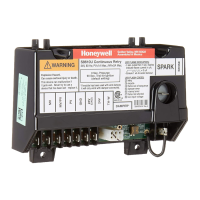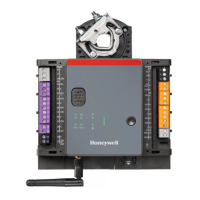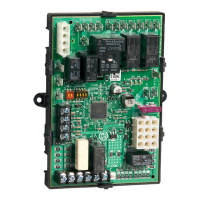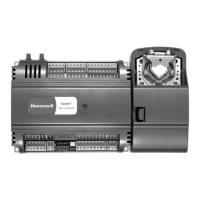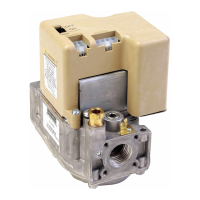EN2R-9031 0402R15-NE 30
SYSTEM OPERATION S4565AD, BD, CD, DD, PD, QD, RD, SD, TD “2000” SERIES
General
The S4565AD, BD, CD, DD, PD, QD, RD, TD ignition controls
can provide both closed-loop sparking and sparking to
ground.
The S4565SD ignition circuit and rectifier provides closed-
loop sparking.
Lock-out reset
The ignition control can be reset by either depressing the
internal/external reset button (suffix AD, BD, CD and DD) or
by interrupting the permanent life (suffix PD, QD, RD and
TD).
NOTE 11.: When first starting, the ignition control can be in
the lock-out condition, depress the reset button
to free the ignition control. After a reset an
extended waiting time will occur.
NOTE 12.: If during normal use the reset button is pressed,
the gas valves close and the ignition control
starts a new sequence after releasing the reset
button.
NOTE 13.: If permanent alarm output:neon indicator with
integral resistor >150 kΩ (max 1 mA).
Do not connect any electrical load to the heat
demand input, it will influence proper functional-
ity.
Suffix AD and PD (see Fig. 35.)
When there is a call for heat a self check period (T
c
) plus
waiting period (T
w
) elapse before the built-in igniter and gas
valve are switched on.
The ignition spark ignites gas and resulting flame is detected
by the flame rod.
After flame establishment a predetermined, extended ignition
time can be included.
If flame is not established within the safety time (T
s
), the
ignition control locks out.
If the flame is lost during normal run, the ignition control
repeats start sequence.
Suffix BD and QD (see Fig. 36.)
As AD and PD except flame relay contact or opto is activated
after flame detection.
NOTE 14.: The hour counter is energized when the valve is
energized. It can be used as an output signal.
Suffix CD and RD (see Fig. 37.)
When there is a call for heat, self check period (T
c
) plus
waiting period (T
w
) elapse if the air proving switch is in the no
air position.
After T
c
+ T
w
the fan starts running.
When sufficient air flow is proven by the air proving switch,
the built-in igniter and gas valve are switched on.
The ignition spark ignites gas and resulting flame is detected
by the flame rod.
After flame establishment a predetermined, extended ignition
time can be included.
If flame is not established within the safety time (T
s
), the
ignition control locks out.
If the flame is lost during normal run, the ignition control
repeats start sequence.
If no air is proven by the air proving switch, the ignition control
stays waiting (optional lock out on no air can be included).
Suffix DD and TD (see Fig. 38.)
As CD and RD except flame relay contact or opto is activated
after flame detection.
Suffix SD (see Fig. 30.)
If line voltage is applied between pin 5 (line valves) and pin 9
(N), the gas valve is switched on.
If the line voltage is applied between pin 4 (line ignition) and
pin 9 (N) the build in igniter is switched on.
The igniter circuit is fed during the negative half wave of the
mains.
Pin 8 is present but not intended for use. It is connected with
a resistor (100 Ω) to pin 5.
Ignition circuit must be on shorter than 10 s in an application
with single ignition trial.
Gas/air application
For gas/air application without dynamic aircheck, the
S4565AD, BD, PD or QD can be used.
In this application the fan is connected between pin 4 and 5
and will start when a call for heat is present. The waiting
period now acts as a prepurge time.
When the call for heat disappears or when the ignition control
goes in lock-out, the fan will be switched off.
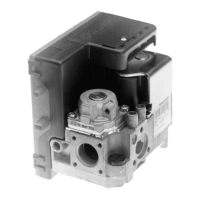
